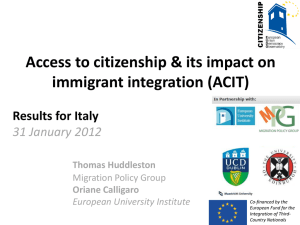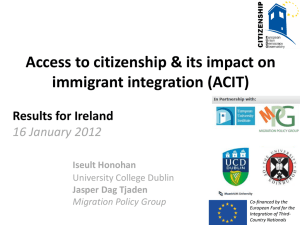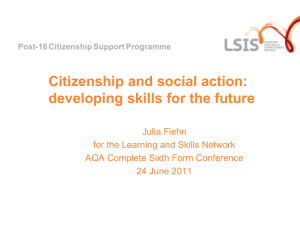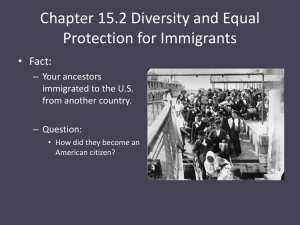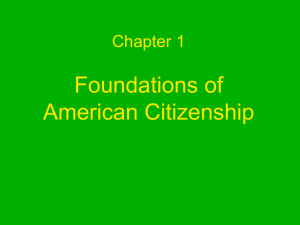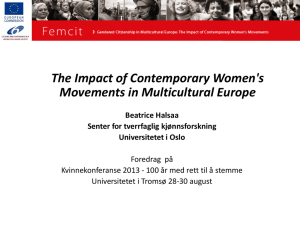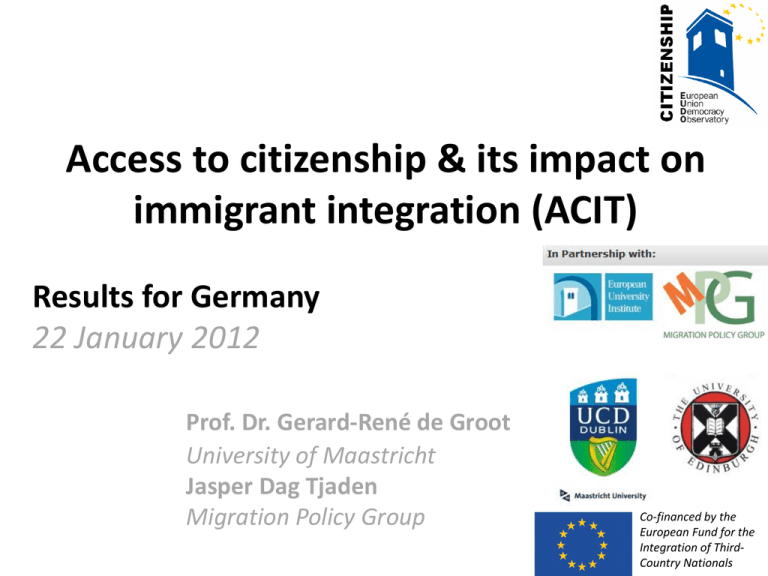
Access to citizenship & its impact on
immigrant integration (ACIT)
Results for Germany
22 January 2012
Prof. Dr. Gerard-René de Groot
University of Maastricht
Jasper Dag Tjaden
Migration Policy Group
Co-financed by the
European Fund for the
Integration of ThirdCountry Nationals
Access to citizenship & its impact on
immigrant integration (ACIT)
http://eudo-citizenship.eu
End date: 31/03/2013
Goal: Researchers & policy actors better understand how law, implementation, and other
factors affect citizenship acquisition and how citizenship affects integration processes;
Goal: Policymakers & civil society use evidence to design more effective laws and measures
Consolidate law indicators
Pilot implementation indicators
Expand ‘outcome’ indicators
Assess determinants of naturalisation across EU
Assess citizenship impact on integration process
10 national citizenship dialogues and national handbooks
EU conclusions, recommendations, dialogue, module
Citizenship Law Indicators
(CITLAW)
• 57 indicators compare specific aspects of citizenship regimes
across countries and time
– basic indicators (e.g. Ius Soli for second generation)
– several combined indicators (e.g. Ius Soli at birth)
– six combined indicators: ius sanguinis, ius soli, ordinary
naturalisation, special naturalisation, renunciation,
withdrawal
• Indicators measure strength of the purpose or principle of the
citizenship law
• Indicator scores range from 0 to 1
0 = purpose/principle not represented
1 = purpose/principle strongly represented
Summary of Findings
Renunciation
Ius Sanguinis
0.9
0.8
0.7
0.6
0.5
0.4
0.3
0.2
0.1
0.0
Ius Soli
Involuntary Loss
Ordinary Naturalisation
Special Naturalisation
Germany
EU-15
EU-27
Ordinary Naturalisation
1.0
0.9
0.83
0.8
0.73
0.71
0.7
0.6
0.64
0.57
0.58
0.55
0.5
0.5
0.630.65
0.61
0.57
0.61
0.47
0.37
0.4
0.3
0.25
0.300.29
0.25
0.25
0.2
0.1
0
0.0
Overall
Residence
Conditions
Renunciation
Germany
Language
Conditions
EU-15
Civic Knowledge / Criminal Record
Assimilation
EU-27
Economic
Resources
Ordinary Naturalisation
opportunities
obstacles
• residence requirement: • Economic resources required
– Belgium
1.00
• Dual nationality restricted
– Germany
0.71
• High-level written language test
– EU-15
0.61
• Use of test for civic knowledge
– Switzerland
0.12
Special Naturalisation (selected modes)
1.0
1
0.9
0.88
0.81
0.8
0.75
0.69
0.7
0.6
0.54
0.3
0.50
0.48
0.46
0.5
0.4
0.75
0.68
0.64
0.39
0.36
0.33
0.29
0.24
0.0
0
0.69
0.5
0.38
0.340.35
0.5
0.46
0.43
0.35
0.31
0.28
0.26
0.21
0.18
0.2
0.1
0.75
0.060.04 0.06
0.02
Germany
EU-15
EU-27
0.23
0.16
0.47
0.380.39
Special Naturalisation
opportunities
• spousal transfer
• adoption
• descendants of former
citizens
• good faith citizens
• refugees
obstacles
• child extension
• no socialisation-based
access for foreign-born
children
• stateless persons
Citizenship Implementation
Indicators (CITIMP)
• 38 indicators compare formal aspects of naturalisation procedure.
These include all stages, from efforts by public authorities to
inform applicants to the options to appeal a negative decision.
• 5 dimensions covered administrative procedure:
1) Promotion: how much do authorities encourage applicants to apply?
2) Documentation: how easily can applicants prove they meet the conditions?
3) Discretion: how much room do authorities have to interpret conditions?
4) Bureaucracy: how easy is it for authorities to come to a decision?
5) Review: how strong is judicial oversight of the procedure?
Summary of Findings
Generally, positive link between law (CITLAW) & implementation (CITIMP)
In contrast, DE has more legal obstacles to naturalise than most EU15,
but fewer procedural obstacles in federal standards and selected laender
DE naturalisation procedures more like FR than any other EU country
• Some state promotion (widest variation in selected laender)
• Some demanding documentation as in other EU15 countries
• Limited discretion within procedure
• Some bureaucratic elements (variation between selected laender)
• Relatively strong judicial review
Promotion
Opportunities
• Campaigns, pilots/materials, ceremonies in Hamburg & a few cities
• Free federal language and integration courses
• Exemptions to high fees
‘Missed’ opportunities—
• Required citizenship ceremonies involving public authorities & media
• Naturalisation campaigns, also targeting attitudes of general public
• Cooperate more in the process with immigrant NGOs
• Legal obstacles may make promotional activities much less effective
Documentation
Opportunities:
• Test exemptions for those completing various forms of schooling in Germany
• Authorities obtain information themselves on criminal record
• Test exemptions generally on vulnerability grounds (e.g. age, illiteracy, illness)
Obstacles:
• Few exemptions on test or economic resources for refugees or stateless persons
• Additional paperwork from country of origin (translated and certified)
• Renunciation fully enforced (requirement is symbolic oath in Spain or United States)
Citizenship acquisition
(CITACQ)
• Acquisition indicators compare rates of citizenship
acquisition among foreign-born in their country of residence
• Percentages of foreign-born immigrants who have acquired
citizenship at any point in time, not naturalisation rates
measuring the number of new naturalisations divided by
resident population with foreign citizenship
• Information based on European Labour Force Survey Ad Hoc
Module (2008) that targets immigrants and their
descendants, aged 15-67
• Data exclusively on foreign-born (1st generation) and allows
for comparisons of citizenship acquisition rates across 25
European countries
Citizenship acquisition
(CITACQ)
Includes information on the following indicators for
citizenship acquisition by foreign-born:
–
–
–
–
ALL
SEX (female vs. male)
ORIGIN (EU vs. non-EU countries)
AGE AT MIGRATION (age at which respondent took up
residence)
– YEARS OF RESIDENCE (years of residence)
– YEARS OF RESIDENCE (minimum number of years of
residence)
– TIME UNTIL NATURALISATION (numbers of years until
naturalisation)
Summary of Findings
• On average around 34% of foreign-born persons are a
citizen of their EU-15 country of residence.
– Citizenship acquisition rates in EU-15 range are lowest in
Luxembourg (10%) and highest in Sweden (67%). In
Germany acquisition rate (43%) is slightly above average.
– Immigrants from non-EU countries (42%) more often
acquire citizenship than those from EU countries (20%).
• On average it takes around 10 years for foreign-born
persons to acquire citizenship of their country of
residence, within EU-15 countries.
– In Luxembourg it takes almost 15 years on average to
naturalise, whereas in Ireland this is around 5 years. In
Germany the speed (9,5 years) is around the EU15 average.
Acquisition rates in EU-15 (+CH, NO)
Germany
Speed of naturalisation
GERMANY
Germany compared I
(% foreign-born with citizenship)
50
45
Germany
43,03
EU-15
44,50
43,23
42,86
42,04
40,06
40
35
34,43
35,67
33,02
30
%
25
20,48
20
15
10
5
0
ALL
SEX (female)
SEX (male)
ORIGIN COUNTRY
(EU)
ORIGIN COUNTRY
(non-EU)
Germany compared II
(% foreign-born with citizenship)
70
Germany
EU-15
60
50
40
%
30
20
10
0
at least 5 years
at least 10 years
at least 15 years
years of residence
at least 20 years
Analysis of acquisition rates
Citizenship acquisition & speed of acquisition are mainly driven by:
• Socio-economic development of countries of origin
• Citizenship laws of the country (see following graph)
Variation in acquisition rates is mainly explained by:
• Marital status (married people are more likely to be naturalised)
• Socio-economic status (employed immigrants are more likely)
• Gender (female immigrants are more likely)
• Use of native language at home (immigrants who speak the
language of the destination country at home are more likely)
Predicted probability of having destination country citizenship
by MIPEX Access to Nationality
(by years of residence in country)
Germany (50)
Germany (50)
MIPEX Access to Nationality score (adjusted for first generation only)
Citizenship and Integration
(CITINT)
• 18 core indicators measure the the extent to which changes in
citizenship status affect levels of integration.
• Three categories of indicators:
– Labour force participation (2008 Eurostat LFS ad hoc module)
– Social inclusion and standard of living (2008 EU-SILC)
– Host society attitudes (ESS rounds 1-5)
• Sample: EU-27, Iceland, Norway, Switzerland
• As expected, immigrants who naturalised are often better off
than immigrants who have not naturalised.
CITINT: Labour Force Participation
Unemployment Rates, 2008 (%)
16
14
12
10
8
6
4
2
0
Germany
EU-15
Natives
Naturalized Immigrants
EU-27
Non-citizen Immigrants
Source: 2008 EU Labour Force Survey Ad Hoc Module
Labour Force Participation
Overqualification Rates, Germany, 2008 (%)
Natives
19.9
27.6
Naturalized Immigrants
27.1
43.6
Non-citizen Immigrants
24.7
0
5
10
15
20
Non-EU
25
30
35
40
45
50
EU
Source: 2008 EU Labour Force Survey Ad Hoc Module
Social Exclusion
Share Having Difficulty Making Ends Meet, 2008 (%)
70
60
50
40
30
20
10
0
Germany
EU-15
Natives
Naturalized Immigrants
EU-27
Non-citizen Immigrants
Source: 2008 EU-SILC Survey
Living Conditions
Social Housing Occupation, 2008 (%)
20
18
16
14
12
10
8
6
4
2
0
Germany
EU-15
Natives
Naturalized Immigrants
EU-27
Non-citizen Immigrants
Source: 2008 EU-SILC Survey
Conclusions
Major legal opportunities
• Residence requirement • Ius soli
Major legal obstacles
• Restrictions on dual nationality • Economic resource requirement
• No socialisation-based entitlement
Major administrative opportunities
• Limited discretion• Promotion measures in laender • Judicial review
Major administrative obstacles
• Documentation required abroad • Test exemptions for refugees/stateless
• Settled immigrants from developing countries are more likely to
naturalise, but policies have major impact on naturalisation rates
• Naturalised German citizens took on average 9,5 years to naturalise
• Still around half of the foreign-born population has not naturalised, even
after 15 or 20 years in Germany

